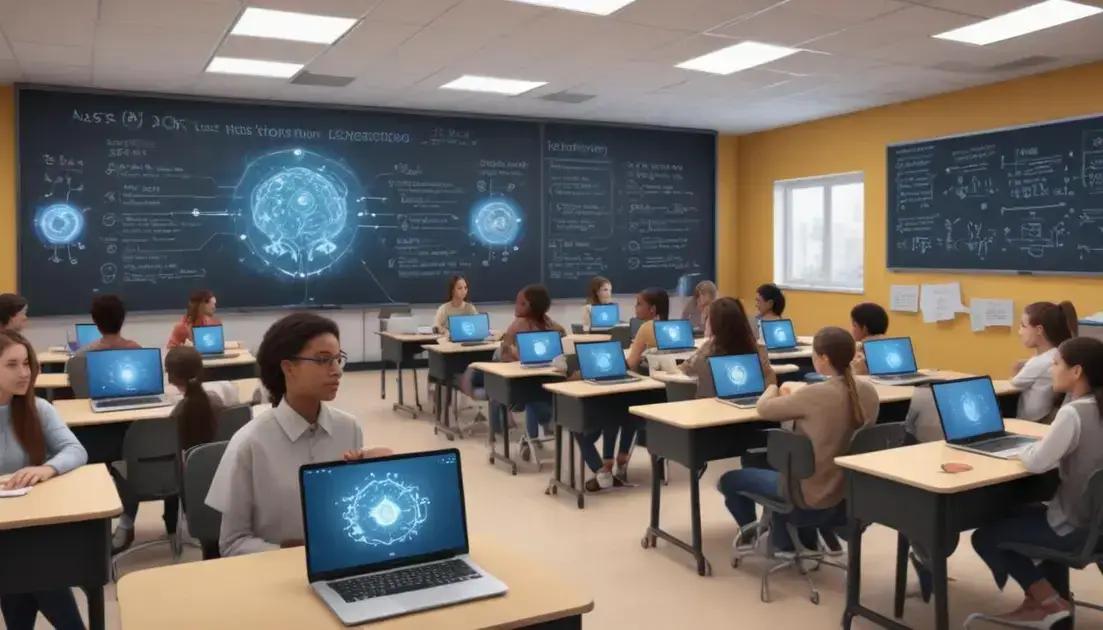AI in education trends: transforming learning experiences
Anúncios
AI in education trends enhance personalized learning through adaptable content and real-time feedback, while also raising ethical considerations such as data privacy and algorithmic bias that need to be addressed responsibly.
AI in education trends are becoming increasingly relevant as institutions seek to enhance learning experiences. Have you ever wondered how these technologies might shape the classrooms of tomorrow?
Anúncios
Overview of AI in education
AI is transforming the education sector by offering innovative solutions that enhance learning experiences. Educational institutions are increasingly turning to AI tools to improve teaching methods and outcomes.
These tools can help personalize learning by adapting to the needs of individual students, addressing their unique strengths and weaknesses.
Anúncios
Key Features of AI in Education
- 🧠Personalized learning: AI can analyze student data to tailor lessons, ensuring each learner grasps the material.
- 🤖Automation: Administrative tasks such as grading and scheduling can be automated, freeing up time for educators.
- 📊Data analytics: AI can provide insights into student performance, helping educators make informed decisions.
Many educators are now using AI technologies, like intelligent tutoring systems and chatbots, to support students outside the classroom. These tools offer guidance and assistance whenever students need help, improving their overall learning experience.
For a more in-depth understanding of how AI is impacting education, you can visit Education Week to explore various case studies and applications.
Benefits of integrating AI in classrooms
Integrating AI in classrooms brings a wealth of benefits for both educators and students. One major advantage is the ability to provide personalized learning experiences.
With AI, teachers can tailor lessons to meet the individual needs of each student, accommodating different learning styles and pacing.
Key Benefits of AI Integration
-
🎮 Enhanced engagement: AI tools can create interactive learning environments that captivate students’ interest
-
📝 Efficient assessment: AI can automate grading, providing teachers with more time to focus on instruction
-
⚡ Real-time feedback: Students receive immediate support when using AI-enabled resources, helping them grasp concepts more effectively
Additionally, AI can assist in identifying students who may need extra help, allowing educators to intervene early.
For more information on the benefits of AI in education, visit Forbes to explore various applications and success stories.
Latest advancements in AI technologies
The field of artificial intelligence is advancing rapidly, bringing forth new technologies that enhance learning and teaching experiences. Recent advancements have made AI tools more effective and accessible for educational settings.
Some of these key advancements include:
Current Trends in AI Technologies
| 🧠 Technology | 📌 Description |
|---|---|
| 🗣️ Natural Language Processing (NLP) | Enables AI to understand and generate human language, supporting more natural communication with users. |
| 📊 Machine Learning (ML) | Uses data to improve predictions and decision-making, such as analyzing and enhancing student performance. |
| 🎓 Adaptive Learning | Personalizes the learning experience by adjusting content based on each student’s pace and comprehension level. |
AI systems are also becoming more user-friendly, with interfaces designed for students and teachers to easily navigate and use various tools. This encourages wider adoption across different educational levels.
For more insights on the latest innovations in AI technologies, check out MIT Technology Review, which offers in-depth articles on cutting-edge developments.
Case studies of successful AI applications

Case studies highlight the real-world impact of AI applications in education, showcasing how these technologies can enhance learning outcomes. Many schools and universities have begun integrating AI systems into their curricula, leading to remarkable results.
Notable examples include:
Examples of Successful AI Integration
-
🧑🏫 Intelligent Tutoring Systems: Some institutions have adopted AI tutoring systems that provide personalized feedback to students, helping them master subjects at their own pace
-
📈 Predictive Analytics: Schools use AI to analyze student performance data, predicting which students may need additional support and improving intervention strategies
-
💬 Virtual Learning Assistants: AI chatbots assist students with questions outside of class hours, ensuring they have access to information when needed
These implementations demonstrate the potential of AI to transform educational experiences, making learning more engaging and effective.
For further reading on successful AI applications in education, visit EdTech Magazine, which shares specific case studies and insights.
Challenges faced in adopting AI
Adopting AI in education comes with several challenges that institutions must navigate. Understanding these obstacles is crucial for effective implementation.
Some common challenges include:
Obstacles to AI Adoption in Education
-
🔐 Data Privacy Concerns: Schools must ensure that student data is secure and that AI systems comply with regulations
-
🔧 Integration with Existing Systems: Many educational institutions struggle to integrate new AI technologies with their current systems and processes
-
👩🏫 Training and Support: Educators often need training to effectively use AI tools, which can require time and resources
Moreover, there can be resistance from staff who feel apprehensive about utilizing AI in the classroom. Addressing these concerns is essential for a smooth transition.
For additional insights on the challenges of AI adoption in education, check out EDUCAUSE, which explores both obstacles and potential solutions.
Future of AI in learning environments
The future of AI in learning environments looks promising as technology continues to evolve. Innovations are expected to enhance both teaching and learning experiences.
Several key developments are on the horizon:
Emerging Trends in AI for Education
-
🧠 Personalized Learning: AI will increasingly tailor educational content to meet the unique needs of individual students, making learning more effective
-
🕶️ Virtual Reality (VR) and Augmented Reality (AR): These technologies will likely be integrated with AI, providing immersive learning experiences that engage students more deeply
-
🤝 Collaborative Learning: AI tools may facilitate better collaboration among students, enabling them to work together seamlessly across digital platforms
As these advancements unfold, educational institutions will have the opportunity to create more dynamic and interactive learning environments.
For more insights into the future of AI in education, visit World Economic Forum for informative articles on evolving trends in the field.
AI-driven personalized learning
AI-driven personalized learning is revolutionizing how students engage with their education. By using data and advanced algorithms, AI can tailor educational experiences to meet the individual needs of each learner.
Some key benefits of this approach include:
Advantages of AI-Driven Personalized Learning
-
🧩 Adaptable Content: AI can analyze a student’s performance and adjust the difficulty level of assignments accordingly, ensuring material is neither too easy nor too hard
-
⚡ Real-Time Feedback: Students receive immediate insights into their progress, helping them understand concepts more deeply and correct mistakes right away
-
🎯 Enhanced Engagement: Personalized experiences keep students motivated by aligning learning with their interests and pace, leading to better outcomes
Many educational institutions are beginning to implement these AI technologies effectively, leading to improved student satisfaction and achievement.
For more information on AI-driven personalized learning, explore resources from Edutopia, which offers insights into the integration of AI in education.
Ethical considerations in educational AI

As AI continues to be integrated into education, ethical considerations become increasingly important. Understanding these concerns is crucial for the responsible use of technology in learning environments.
Several key ethical issues include:
Key Ethical Considerations for Educational AI
-
🔐 Data Privacy: Protecting student information is essential. Schools must ensure AI systems comply with privacy laws and secure personal data
-
⚖️ Bias and Fairness: AI algorithms can unintentionally reflect biases present in training data, leading to unfair treatment of certain groups of students
-
🧾 Accountability: When decisions are made by AI systems, it is important to establish who is responsible for those decisions, especially in cases of error
Addressing these ethical challenges will help promote trust and acceptance of AI technologies in education.
For more insights on this topic, check out resources available at EDUCAUSE, which discusses the implications of AI ethics in educational settings.
In summary, embracing AI in education offers exciting possibilities
The integration of artificial intelligence provides personalized learning experiences that cater to individual student needs. Schools can benefit from enhanced engagement, real-time feedback, and adaptable content.
However, with these advancements come important ethical considerations that educators must address to protect student privacy and ensure fairness. Challenges like data privacy and algorithmic bias require careful attention and proactive solutions.
As educational institutions continue to evolve, embracing AI thoughtfully can lead to innovative learning environments. By prioritizing both the benefits and ethical implications, we can create a brighter future for education with technology at the forefront.






